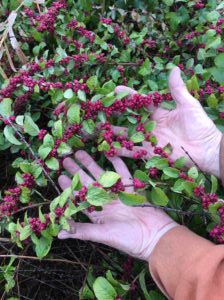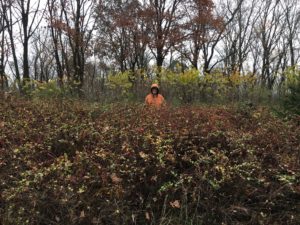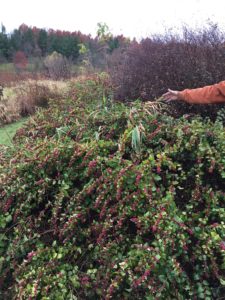Coralberry: A Versatile Native Shrub
Our native coralberry is also called buckbrush. Most commonly found as a low, spindly, scrawny shrub with a few leaves and a few little pinky-purple berries, growing in the shade of canopy trees in a woods. However, on rare occasions under an open canopy or in full sun, individual plants can be robust, about four or five feet tall, and covered with leaves and fruits.

Close up of leaves and berries of robust coralberry, following some light frosts.
If you plant seed from robust parents, the next generation is mostly throwbacks from past scrawny generations. But the species is so easy to propagate vegetatively, either from dormant stem cuttings or root suckers, that it is not difficult to obtain as many clones from a robust individual as you wish.
Many years ago I came across a nice specimen growing on the banks of Walnut Creek in southcentral Iowa. The land was initially purchased to become a buffer zone for a future nuclear power plant, but was later repurposed to become the Neal Smith National Wildlife Refuge (which is why I was there with a grad student to study the creek). Later I found another nice specimen on Corps of Engineers land beside the Coralville Reservoir. Both sites had formerly had farmhouses somewhere nearby, so either of my specimens could have a bit of selection somewhere back in its lineage. But I propagated both at home and they have been growing in mixed wildlife thickets, and I cannot tell them apart.
Birds eat the little purplish berries, especially when other fare is scarce (Degraff and Whitman, 1979, list 14 bird species). It spreads steadily by aboveground root suckers, which pop up right beside the parent and gradually exclude most other species, making a dense thicket of very fine twigs – perfect for little birds to build nests in. Deer nibble the topmost twigs in winter, hence the name buckbrush. The flowers are an abundance of tiny pinkish-green bells, which you may overlook, except that the hummingbirds work them steadily.

A 10- or 12-year-old thicket of coralberry.
Overall, it is a readily growing thicket-former, useful to wildlife. I find it easy to control by mowing the new suckers that come up out of bounds. And it never grows more than 5 or 6 feet tall, so it can form the outer perimeter of a wildlife planting, which doesn’t cast shade on other species.

Wisps of reed canary grass in my hand, still surviving, as coralberry chokes it out.
Within its working area and in full sun, it can be aggressive. Not fussy about soils, it will grow in a wide range from dry mesic to edge of wetland, but like many other species prefers well-drained, well-watered sites in full sun. It is one of the few species I know of that can outcompete reed canary grass. I have a patch of this grass at home that appeared in a place where driveway runoff provides extra water. I surrounded it with a half dozen coralberry transplants perhaps five years ago and today the grass has been reduced to a small handful of grass blades reaching up and out of the coralberry thicket.
The plant breeders of Holland have taken notice of this durable species, not only growing and selecting for bigger and more abundant berries, but also crossing it with its kissing cousins in the snowberry family. Left to themselves, the snowberries produce white pulpy berries up to a half-inch in diameter, which can also linger into winter and serve as wildlife food. But by crossing, the breeders have created smallish yard shrubs that produce an abundance of large pink to purple decorative berries. These are now just entering the trade, in catalogues and at retail nurseries. These hybrids are beyond the pale for me, as I am attempting to stick with natives, and I have no experience to share regarding the hybrids. But if you want to try a patch of my selection, to incorporate more natives in your own landscape, I can get you started in mid-March, right after the ground thaws.


